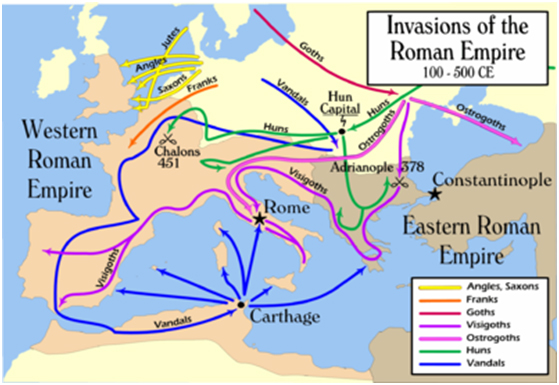In ancient times, a people came from the Near East across Asia and Europe. Known in later generations as the Indo-Aryan people, some settled in the Caucasus Mountains, and those of Persia (Iran); others, in Mesopotamia and Sumerian; and others in the Balkan states of Macedonia, Mesopatania, Bulgaria and Romania; and others in northern Europe, Germany, Scandinavia, France, Spain and Britain. They were tall, fierce, fair-haired and fair-skinned people in contrast to their swarthy counterparts from whence they had travelled.
Some of the early invasions of Europe began in the 5th century BC when tribes of Germanic origin advanced into Roman Empire lands. The attack wasn’t spontaneous but due to the pressure of the Hun s that were moving from central Asia to Europe, taking Germanic tribe land. Finally, the Huns invaded the Roman Empire, but were defeated in the battle of Campos Catalunicos with the aid of the adjacent Visigoths tribes.
Rome in the the 3rd century on suffered the attacks of several barbarian tribes, but wasn’t prepared as in the past to resist. Rome was in the middle of an economic, social and political crisis.
These Indo-Aryan tribes had strength, stamina and charisma. They were respected by those they helped and feared by those who opposed them. In northern Europe, they became known as the Tetons, Norse, Goths and Celts.
Settling deep in the regions of north Europe, they were forgotten by the city-states to the south and east such as Greece, Persia and Egypt. During the Iron Age, these war-like cultures re-emerged, clashing with the civilizations fronting the Mediterranean Sea; Greece and Rome. The fierce warlike nature and vicious behaviors earned them the name “BARBARIANS.”
401 AD Alaric King of the Visigoths penetrated Italy. In 406 AD, menaced by the Huns, the Vandals, Suaves, Burgundies and Alans crossed the Rhine River. In 410 AD, the Visigoths with help of some Ostrogoths sacked Rome.
455 AD Vandals attack Sicily and other isles, and sack Rome. 476 AD The Germanic troops in Italy rebelled and claimed Odoacer as King of Italy and end of the Western Roman Empire. After the invasion of the Roman Empire, a territorial fragmentation began that came to an end with the consolidation or the Western Roman Empire within the Charlemagne Empire some time later.

|

